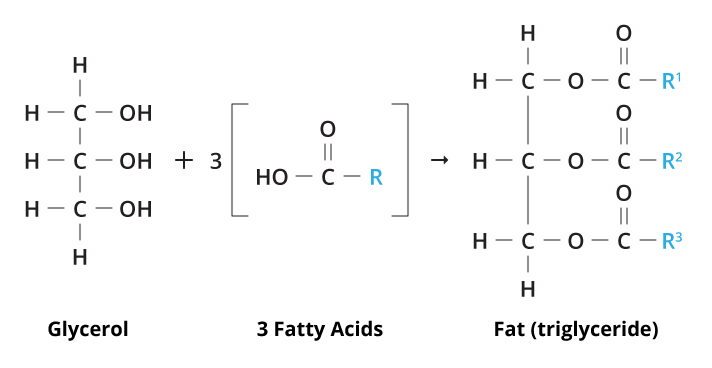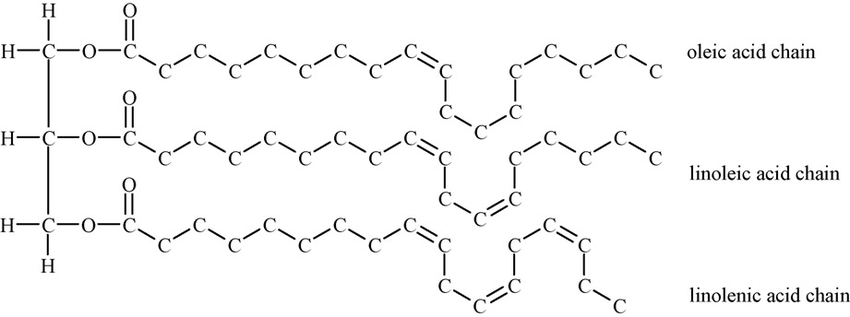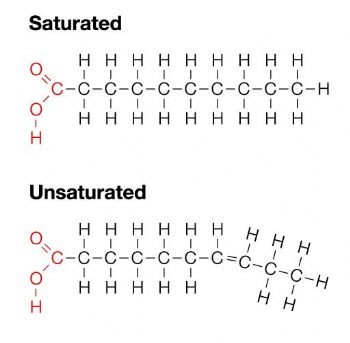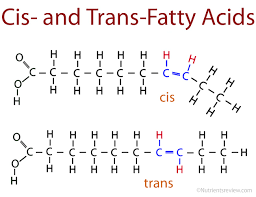A fat is an ester of fatty acids. Fats are a type of lipid, although they’re often used synonymously.

The molecular structure of vegetable oil looks like this, for example:

Unsaturated Fats
Unsaturated fats are fats that contain at least 1 Carbon-Carbon double bond in the fatty acid chain.

- Liquid at room temperature.
- Mostly sourced from plants rather than animals.
- Generally considered ‘healthy’ fats because they can reduce LDL cholesterol levels.
There are:
- Monounsaturated fats — contains exactly one double bond.
- Sourced from avocados, nuts, seeds, plant oils for example.
- Polyunsaturated fats — contains more than one double bond.
- Polyunsaturated fats can be subdivided into omega fatty acids like omega-3 and omega-6.
- Omega-3 fats are important polyunsaturated fats sourced mainly from fish, nuts and seeds. They cannot be synthesised by the body.
- The number, 3 and 6 in ‘omega-3’ and ‘omega-6’, just mean the position of the double bond in the fatty acid carbon chain. It happens that omega-1, omega-2, etc. are not common in natural-occurring foods, so we don’t discuss them as much as omega-3 and omega-6.
- Polyunsaturated fats can be subdivided into omega fatty acids like omega-3 and omega-6.
Plant-based oils are not necessarily better for you than animal fat because they’re much more susceptible to oxidation, which produces toxic byproducts like aldehydes which are believed to be contributors to heart disease, Alzheimer’s, etc.
- Monounsaturated fats are much more vulnerable to oxidation. Polyunsaturated fats are an order of magnitude even worse (hence why olive oil should be stored in a cool dark place as light and heat speed up oxidation).
- The processing required to produce many plant-based oils involves subjecting the oil to very high temperatures.
- Extra virgin olive oil is probably the least bad widely available plant-based oil because it’s the least refined.
Trans Fat
The double bond in unsaturated fats allows for 2 possible arrangements of atoms: cis and trans.
 Unsaturated fats arranged in the trans configuration are trans fats. The shape of a fat makes a huge difference.
Unsaturated fats arranged in the trans configuration are trans fats. The shape of a fat makes a huge difference.
- Like saturated fats, trans fats increase LDL (by stimulating cholesterol synthesis in the liver) and decrease HDL cholesterol. They’re considered worse for health than saturated fats, despite being an unsaturated fat which is credited with being healthier than saturated fats.
- Trans fats are very cheap to synthesise and are useful for increasing shelf life and for frying.
- Trans fats occur naturally in small amounts in meat and dairy.
Fat hydrogenation is a technique used to convert unsaturated fats to trans fats. To know whether a food has trans fat, look for the words ‘partially hydrogenated’. It is insufficient to just look for 0g trans fat.
Trans Fats
Trans fat is a class of unsaturated fats, considered the worst kind of fat to eat because it tends to increase LDL cholesterol and reduce HDL cholesterol.
Saturated Fats
Saturated fats are fats containing no Carbon-Carbon double bonds in the fatty acid chain.
- Mostly sourced from animals, and some plant sources such as coconut oil.
Saturated fats are considered unhealthy because they increase LDL cholesterol levels by reducing the effectiveness of LDL receptors in the liver.
Healthy Limits
In general, the American Heart Association recommends 5% of daily caloric intake to be from saturated fats. More broadly, the rule is no more than 10% of daily calories should be from saturated fat.
If you need 3000 calories a day, then around 150 calories should be from saturated fat. How many grams is that? Divide 150 by 9 (saturated fat is roughly 9 calories/gram), which gives 16.67g.
Example food items
- Meat:
- Chicken breast: 100g has 1g saturated fat.
- Beef:
- Steaks: depends on which part of the cow, but generally 1-10% by weight is saturated fat. 100g of flank stake has 3.4g.
- Liver is low in saturated fat, typically 1.4% of weight is saturated fat.
- Pork:
- Steaks and chops are low in saturated fat, typically <5% by weight.
- Belly, ribs, sausages, mince and bacon are higher. Expect around 10-20% saturated fat by weight.
- Lamb
- Similar to pork.
- Dairy:
- Milk: expect around 5g per cup for whole milk. For skim milk, expect significantly lower, at around 0.1g.
- Cheese: depends on type, but expect between 10-20% saturated fat by weight. 100g of mozzarella cheese has 11g of saturated fat.
- Eggs: 1.6g
- Butter: 50% by weight is saturated fat.
- Yoghurt: expect around 3% of weight to be saturated fat. Low fat Greek yoghurt has around 0.4% of weight as saturated fat.
- Coconut milk, coconut cream, coconut oil.
- Desserts and processed food in general have unexpectedly high saturated fat.
Also watch out for plant sources of saturated fat:
- Peanut butter is around 10% saturated fat by weight.
- 1 whole avocado has around 4g.
- A handful of mixed nuts should have around 4g.
- 1 tbsp of cocoa powder has 0.4g.
Generally though, fruits and vegetables have very low amounts of saturated fats. The main sources are still meat and dairy.